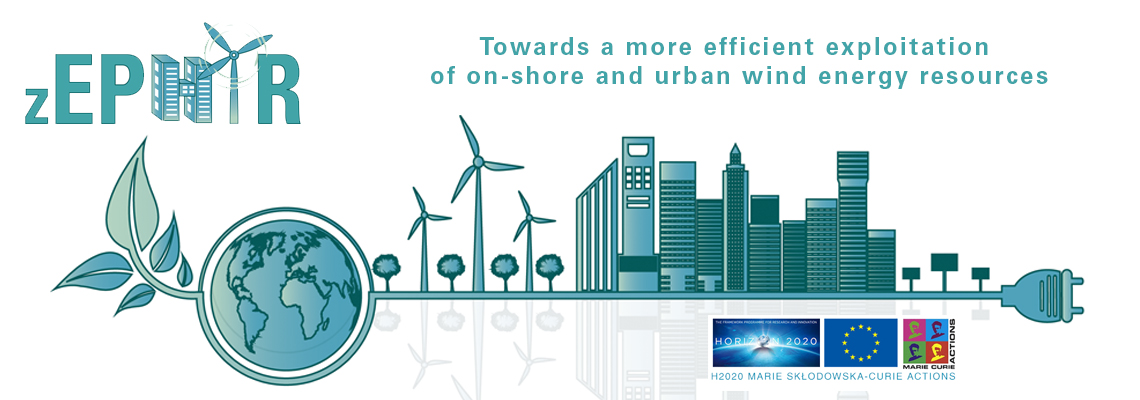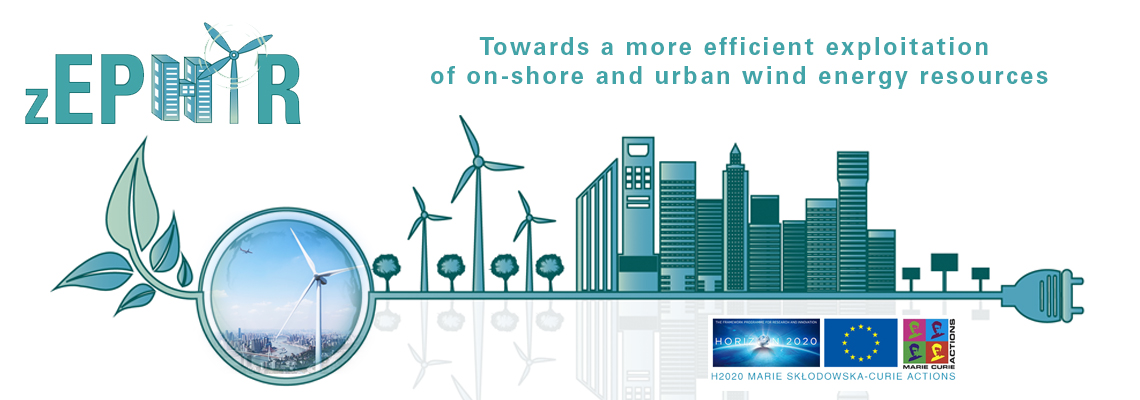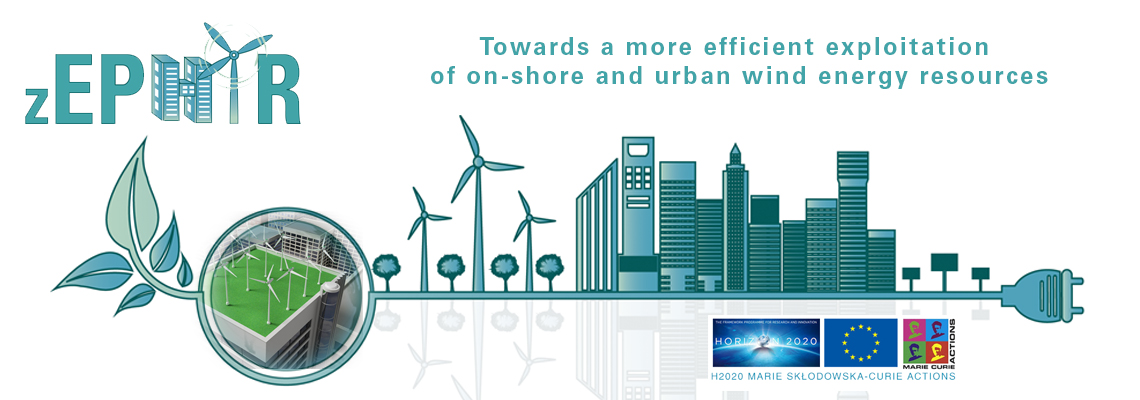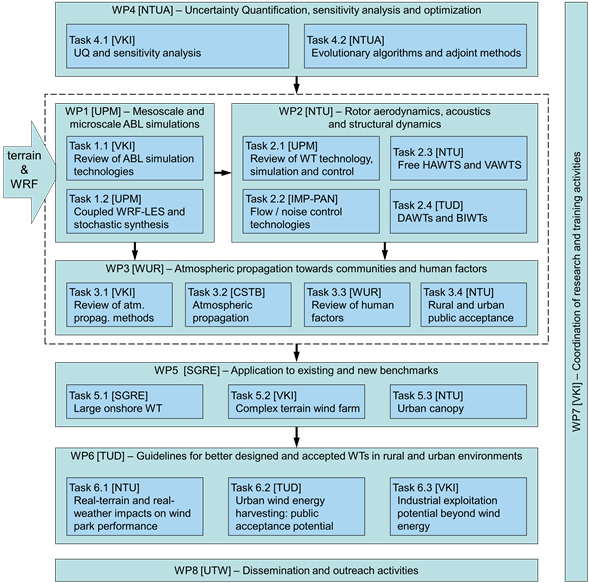The research methodology is illustrated in teh figure below.
 The entry point is the selection of a topography and WRF model, permitting to conduct reliable atmospheric boundary layer (ABL) simulations in WP1 and determine the flow field in which the potential wind park would be positioned, accounting for local topography and flow field.
The entry point is the selection of a topography and WRF model, permitting to conduct reliable atmospheric boundary layer (ABL) simulations in WP1 and determine the flow field in which the potential wind park would be positioned, accounting for local topography and flow field.
 Based on this first output, detailed simulations of the flow field around a specific WT can be carried out in WP2, in order to predict the unsteady loads applied to the blades along one or several revolutions of the rotor. A multi-disciplinary panel of attributes will be considered in this WP: unsteady aerodynamics, aeroacoustics and structural dynamics including aeroelasticity and fatigue life prediction. Activities related to HAWTs, VAWTs, DAWTs and BIWTs will be conducted, together with an assessment of the potential of advanced flow/acoustic control technologies to alleviate flow separation and minimize noise generation.
Based on this first output, detailed simulations of the flow field around a specific WT can be carried out in WP2, in order to predict the unsteady loads applied to the blades along one or several revolutions of the rotor. A multi-disciplinary panel of attributes will be considered in this WP: unsteady aerodynamics, aeroacoustics and structural dynamics including aeroelasticity and fatigue life prediction. Activities related to HAWTs, VAWTs, DAWTs and BIWTs will be conducted, together with an assessment of the potential of advanced flow/acoustic control technologies to alleviate flow separation and minimize noise generation.
 The results produced in WP1 and WP2 will then feed into WP3, dedicated to the propagation of the acoustic perturbations towards the communities, being located in rural or urban environments. Atmospheric propagation effects such as sound refraction due to temperature / velocity gradients and dissipation will be predicted based on the atmospheric database developed in WP1, by propagating the near-field acoustic field that is obtained in WP2. The integration of the tools and methods developed in WPs 1, 2 and 3 constitutes the kernel of the simulation methodology that will be developed in zEPHYR and applied to benchmarks in WP5.
The results produced in WP1 and WP2 will then feed into WP3, dedicated to the propagation of the acoustic perturbations towards the communities, being located in rural or urban environments. Atmospheric propagation effects such as sound refraction due to temperature / velocity gradients and dissipation will be predicted based on the atmospheric database developed in WP1, by propagating the near-field acoustic field that is obtained in WP2. The integration of the tools and methods developed in WPs 1, 2 and 3 constitutes the kernel of the simulation methodology that will be developed in zEPHYR and applied to benchmarks in WP5.
 The work planned in WP4 will address several critical aspects when considering variable atmospheric simulations and wind turbine design: Uncertainty Quantification (UQ), sensitivity analysis and optimization methods. UQ and sensitivity analysis techniques are necessary to evaluate in quantitative terms the impact of the intrinsic uncertainty that affects WRF models on the unsteady loads and associated sound production / structural dynamics. Optimization techniques will be applied to selected wind turbine concepts and flow/acoustic control technologies, including the results of UQ to derive robust design practices.
The work planned in WP4 will address several critical aspects when considering variable atmospheric simulations and wind turbine design: Uncertainty Quantification (UQ), sensitivity analysis and optimization methods. UQ and sensitivity analysis techniques are necessary to evaluate in quantitative terms the impact of the intrinsic uncertainty that affects WRF models on the unsteady loads and associated sound production / structural dynamics. Optimization techniques will be applied to selected wind turbine concepts and flow/acoustic control technologies, including the results of UQ to derive robust design practices.
 The methods and tools developed in the above WPs will be then applied cooperatively by the ESRs to three benchmark studies in WP5: an isolated large (5-10 MW) wind turbine, an on-shore wind park with complex terrain and an urban canopy selected from one of the European Smart Cities and Community Lighthouse projects . While some atmospheric boundary layer databases exist for a couple of documented rural terrain configurations such as the Askervein Hill or the Mower County wind farm , or for urban environments such as Oklahoma City , the available data are not sufficient to estimate the aerodynamic performance, noise emissions nor fatigue life of a WT. The application of state-of-the-art modelling techniques in zEPHYR will thus generate new documented benchmark data with the required level of detail, which will be made publicly available.
The methods and tools developed in the above WPs will be then applied cooperatively by the ESRs to three benchmark studies in WP5: an isolated large (5-10 MW) wind turbine, an on-shore wind park with complex terrain and an urban canopy selected from one of the European Smart Cities and Community Lighthouse projects . While some atmospheric boundary layer databases exist for a couple of documented rural terrain configurations such as the Askervein Hill or the Mower County wind farm , or for urban environments such as Oklahoma City , the available data are not sufficient to estimate the aerodynamic performance, noise emissions nor fatigue life of a WT. The application of state-of-the-art modelling techniques in zEPHYR will thus generate new documented benchmark data with the required level of detail, which will be made publicly available.
 The outcomes of this WP will be analysed in detail in WP6 in order to extract guidelines and conclusions about the two main questions addressed by zEPHYR: i) what is, in quantitative terms, the impact of accounting for real terrain effects and variable atmospheric conditions on the predicted performance and noise of a wind turbine or wind park? ; ii) what is the wind energy harvesting potential of a representative city layout, and what are the public acceptance issues that should be tackled in order to realize that potential?
The outcomes of this WP will be analysed in detail in WP6 in order to extract guidelines and conclusions about the two main questions addressed by zEPHYR: i) what is, in quantitative terms, the impact of accounting for real terrain effects and variable atmospheric conditions on the predicted performance and noise of a wind turbine or wind park? ; ii) what is the wind energy harvesting potential of a representative city layout, and what are the public acceptance issues that should be tackled in order to realize that potential?
 WP7 ensures the good coordination of the management, scientific and training activities. The applicants acknowledge that this consortium is rather large compared to the standards of European Training Networks, being for the sake of the variety of technologies, scientific disciplines and sectors of activity to which the ESRs will be exposed. It does therefore require an efficient management of the research, trainings, and secondments of the fellows.
WP7 ensures the good coordination of the management, scientific and training activities. The applicants acknowledge that this consortium is rather large compared to the standards of European Training Networks, being for the sake of the variety of technologies, scientific disciplines and sectors of activity to which the ESRs will be exposed. It does therefore require an efficient management of the research, trainings, and secondments of the fellows.
 Finally, WP8 implements all required measures for an efficient dissemination of the research outcomes, exposure to general public through outreach actions, and defines a Data Management Plan in line with the Open Science initiative.
Finally, WP8 implements all required measures for an efficient dissemination of the research outcomes, exposure to general public through outreach actions, and defines a Data Management Plan in line with the Open Science initiative.




